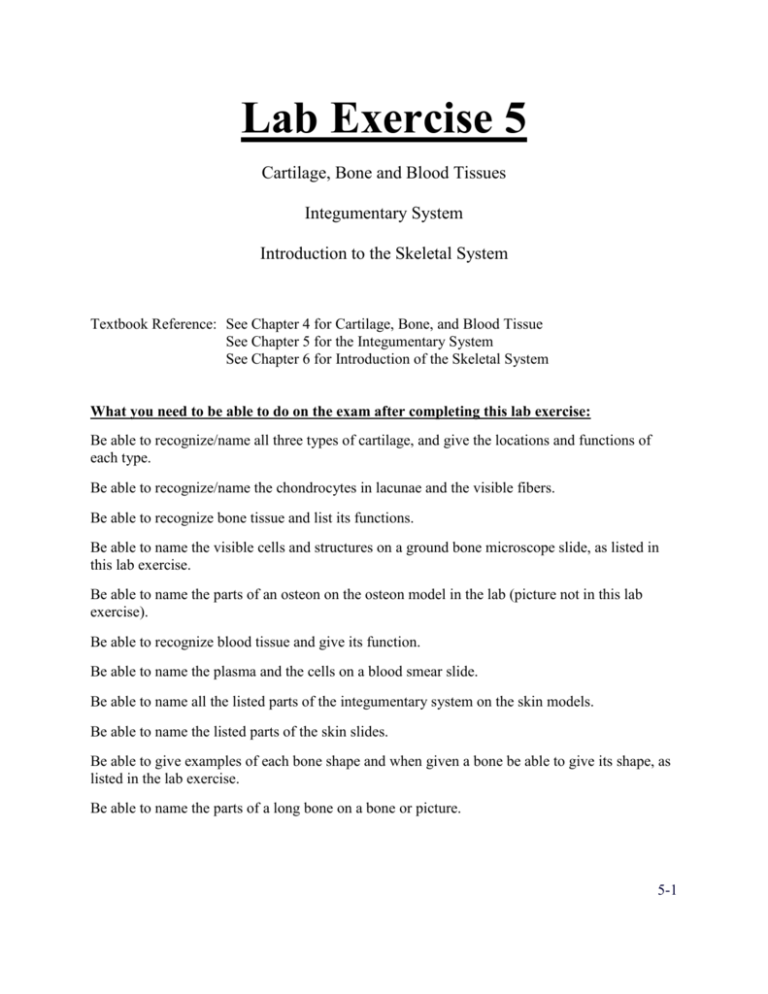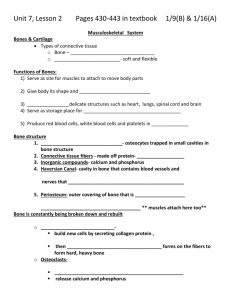Lab Exercise 5
advertisement

Lab Exercise 5 Cartilage, Bone and Blood Tissues Integumentary System Introduction to the Skeletal System Textbook Reference: See Chapter 4 for Cartilage, Bone, and Blood Tissue See Chapter 5 for the Integumentary System See Chapter 6 for Introduction of the Skeletal System What you need to be able to do on the exam after completing this lab exercise: Be able to recognize/name all three types of cartilage, and give the locations and functions of each type. Be able to recognize/name the chondrocytes in lacunae and the visible fibers. Be able to recognize bone tissue and list its functions. Be able to name the visible cells and structures on a ground bone microscope slide, as listed in this lab exercise. Be able to name the parts of an osteon on the osteon model in the lab (picture not in this lab exercise). Be able to recognize blood tissue and give its function. Be able to name the plasma and the cells on a blood smear slide. Be able to name all the listed parts of the integumentary system on the skin models. Be able to name the listed parts of the skin slides. Be able to give examples of each bone shape and when given a bone be able to give its shape, as listed in the lab exercise. Be able to name the parts of a long bone on a bone or picture. 5-1 Cartilage, Bone, & Blood Tissues Cartilage is a tough, but flexible, tissue in the body. It contains collagen fibers and elastic fibers. The cells, called chondrocytes, are located in depressions, called lacunae, in the matrix. There are 3 types of cartilage: hyaline cartilage, elastic cartilage, and fibrocartilage. Hyaline Cartilage Identification: Overall smooth, glassy appearance with distinctive lacunae, most occupied by chondrocytes (arrow); lacunae are often paired Location: nose, larynx, trachea, between ribs and sternum, ends of long bones Function: structural support; cushions joints Fibers present: collagen fibers (not visible) Features to know: chrondrocyte in lacuna (arrow) Elastic Cartilage Identification: distinctive large, often paired lacunae; extensive dark elastic fibers (2) Location: earlobe, epiglottis Function: flexibility Fibers present: elastic fibers (collagen fibers are also present but not visible) Features to know: chondrocyte in lacuna (1), elastic fibers (2) 5-2 Fibrocartilage Identification: nearly parallel (often blue) collagen fibers and the distinctive chondrocytes in lacunae (arrow) Location: intervertebral disks, pubic symphysis, meniscus of knee joint Function: resists compressive forces Fibers Present: collagen Features to know: chondrocyte in lacuna (arrow) Identifying Cartilage Tissues Under the Microscope Procedure: Hyaline Cartilage 1. Obtain a hyaline cartilage slide and bring into focus using the scanning lens (4X). Look for the large chondrocytes and lacunae. 2. Focus on the cells, position them to the center of your field of view, and switch to the low power lens (10X). 3. Focus on a few cells, position them to the center of your field of view, and switch to the high power lens (40X). Notice the smooth background and the large, distinctive chondrocytes in their lacunae. 4. Make a drawing of the tissue on high power in the space below. Label the chondrocytes and lacunae. 5-3 Elastic Cartilage 1. Obtain an elastic cartilage slide and bring into focus using the scanning lens (4X). Look for the dark elastic fibers and large chondrocytes in lacunae. 2. Focus on the cells, position them to the center of your field of view, and switch to the low power lens (10X). 3. Focus on a few cells, position them to the center of your field of view, and switch to the high power lens (40X). Notice the dark elastic fibers and the large, distinctive chondrocytes in their lacunae. 4. Make a drawing of the tissue on high power in the space below. Label the chondrocytes, lacunae, and elastic fibers. Fibrocartilage 1. Obtain a fibrocartilage slide and bring into focus using the scanning lens (4X). Look for the nearly parallel collagen fibers and chrondrocytes in lacunae. 2. Focus on the cells, position them to the center of your field of view, and switch to the low power lens (10X). 3. Focus on a few cells, position them to the center of your field of view, and switch to the high power lens (40X). Notice the collagen fibers and the distinctive chondrocytes in their lacunae. 4. Make a drawing of the tissue on high power in the space below. Label the chondrocytes, lacunae, and collagen fibers. 5-4 Bone Tissue Bone tissue is a living tissue consisting of three types of cells. The mature bone cells are called osteocytes. The osteocytes are located within shallow depressions, called lacunae, in the hard, bony matrix. The basic structural unit of compact bone is called the Haversian system, or osteon. It consists of a central opening, called the Haversian (or central) canal. Surrounding this canal are concentric rings of bony matrix. These concentric rings are called lamellae. Between the lamellae are the osteocytes within lacunae. Very small canals run perpendicular to the lamellae. These tiny canals are called canaliculi. Bone tissue Identification: large, dark circles with concentric circles surrounding it, much like tree rings Location: bones Function: support, protection, mineral storage, attachment sites for muscles Features to know: lamellae (1), osteocytes in lacunae (2), canaliculi (3) and Haversian (central) canal (4). The entire circular unit, including the Haversian canal and the lamellae, is called the Haversian system (or osteon). 5-5 Identifying Bone Tissue Under the Microscope Procedure: 1. Obtain a ground bone slide and bring into focus using the scanning lens (4X). Look for the circular osteons. 2. Focus on an osteon, position it to the center of your field of view, and switch to the low power lens (10X). 3. Focus on the lamellae, position them to the center of your field of view, and switch to the High power lens (40X). Notice dark osteocytes in the lacunae and the tiny canaliculi. 4. Switch back to the low power lens and make a drawing of the tissue in the space below. Focus on an osteon and label the Haversian (central) canal, lamellae, osteocytes in lacunae, and canaliculi. Blood Tissue Blood tissue consists of a liquid matrix, called plasma, and formed elements. The formed elements include erythrocytes (red blood cells), leukocytes (white blood cells), and platelets (thrombocytes). The erythrocytes are small and pink. They lack a nucleus. The center is depressed and usually appears lighter than the rest of the cell. The leukocytes are usually stained purple. They are fewer and larger than the erythrocytes. Most leukocytes have either a bi-lobed or multi-lobed nucleus. The platelets are small cell fragments that are stained blue or purple. They are smaller than the erythrocytes and are scattered between the cells in the tissue. 5-6 Blood Identification: Numerous pink, round red blood cells with larger, purple white blood cells scattered throughout Location: within the blood vessels Function: transport of nutrients, gases, wastes. Etc Features to know: plasma (white background), erythrocytes (round and pink), and leukocytes (1) Identifying Blood Tissue Under the Microscope Procedure: 1. Obtain a blood smear slide and bring into focus using the scanning lens (4X). Look for numerous, very small pink circles with larger purple cells scattered throughout. 2. Focus on the cells, position them to the center of your field of view, and switch to the low power lens (10X). 3. Focus on a few cells, position them to the center of your field of view, and switch to the high power lens (40X). 4. Make a drawing of the tissue on high power in the space below. Label the plasma, erythrocytes, and leukocytes. 5-7 The Integumentary System The Integumentary System includes the skin, hair, and nails. Three main layers of the skin include the epidermis (outermost layer), dermis (main middle layer), and the hypodermis (innermost layer). The epidermis is stratified squamous epithelial tissue consisting of 4-5 distinct layers. The layers of the skin, other than the palms and soles, include: Stratum corneum – outermost layer consisting of several layers of flattened dead cells Stratum granulosum – second, thin, layer consisting of cells with keratin granules Stratum spinosum – thickest layer of the epidermis Stratum basale – bottom-most dark, thin layer consisting of pigmented cells The dermis is dense irregular connective tissue. It consists of two main layers: (1) the thin uppermost papillary layer is folded into peg-like projections called dermal papillae; and (2) the thick reticular layer, which accounts for the majority of the dermis, consists of several appendages, including hair follicles, sebaceous glands, arrector pili muscles, sweat glands, Meissener’s corpuscles, and Pacinian corpuscles. Most sebaceous glands are formed from the hair follicle and are located beside the hair follicle. The hair follicle produces the hair. The arrector pili muscle is attached to the hair follicle. When it contracts, it pulls the hair follicle up and forms a “goose bump”. The sweat glands are located throughout the dermis and have a duct that leads to the outside of the skin. Meissener’s corpuscles are small, encapsulated sensory nerve endings located near the top of the dermis. Pacinian corpuscles are larger plate-like sensory nerve endings located near the bottom of the dermis. The hypodermis consists of adipose tissue and is not considered part of the skin. It is below the skin. 5-8 Know the following parts of the skin model: Epidermis Stratum corneum Stratum granulosum Stratum spinosum Stratum basale Dermis Papillary layer Dermal papillae Reticular layer Meissner’s corpuscle Hair follicle Sebaceous gland Arrector pili muscle Sweat gland Pacinian corpuscle Hypodermis 5-9 Microscopic Investigation of the Skin Bald Scalp In a cross-section of a bald scalp, you can see sweat glands (1), sebaceous gland (3), and hair follicle (4). All of these are found in the reticular layer (2). 5-10 Scalp with Hair The visible layers of the epidermis include the outer stratum corneum layer (5), the thick stratum spinosum layer (6), and the thin, dark stratum basale (7). The dermis consists of the upper papillary layer (8) and the main reticular layer (9). You can see the prominent hair follicle (2) and hair (1). You should also be able to see the sebaceous glands (3). Also visible may be the arrector pili muscle (4) and the hypodermis (10). Identifying Skin Tissue Under the Microscope Procedure: 1. Obtain a skin (scalp) slide and bring into focus using the scanning lens (4X). Look for the epidermal layers, the hair follicles, and sebaceous glands. 2. Focus on the tissue, position it to the center of your field of view, and switch to the low power lens (10X). 3. Make a drawing of the tissue on low power in the space below. Label the epidermis, dermis, hair follicle, and sebaceous gland (if visible). You may need to move the slide around while viewing it to see all the features. 5-11 Introduction to the Skeletal System Bone Shape The Skeletal system consists of bones and ligaments. Human bones come in different sizes and shapes. Bones can be classified on the basis of shape. Common bone shapes include long bones, short bones, flat bones, and irregular bones. Long bones are longer than they are wide. Long bones include all bones of the limbs, except the patella (kneecap), wrist bones, and ankle bones. Short bones are smaller than long bones and many are roughly cube-shaped. Short bones include the wrist bone and ankle bones. A sesamoid bone is a type of short bone that is shaped like a sesame seed and form in a tendon. The patella is an example of a sesamoid bone. Flat bones are flattened bones. Flat bones include the sternum (breastbone), scapulae (shoulder blades), ribs, and most skull bones. Irregular bones are irregularly shaped and do not fit into any of the preceding categories. Irregular bones include the vertebrae and hip bones. **Know the examples of each type of bone shape on display in the lab Structure of a Long Bone The shaft of a long bone is called the diaphysis. Each knob-like end is called an epiphysis. The canal that runs through the diaphysis is called the medullary cavity. It is surrounded by a thin layer of porous spongy bone, which is surrounded by a thicker layer of hard compact bone. The epiphyses contain spongy bone. **Know the following parts of a long bone on the long bone model in the lab. 5-12








